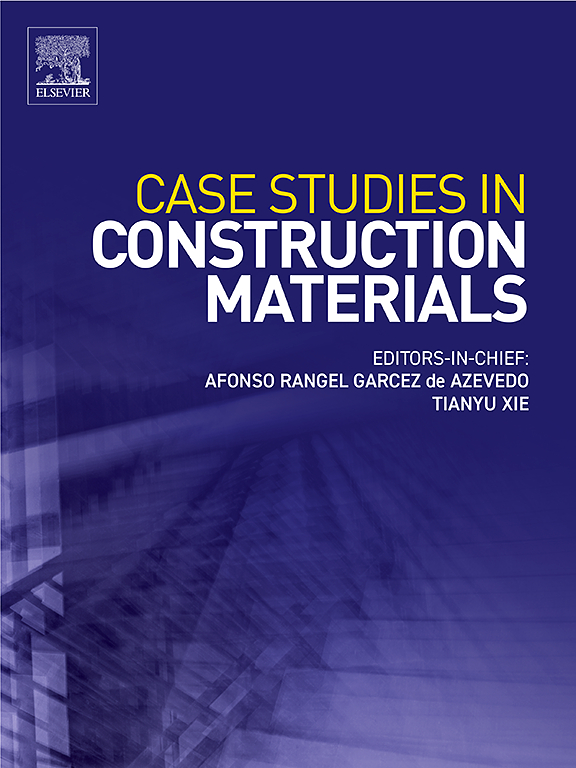评估CLT建筑的湿度安全策略-预测与实际结果
IF 6.6
2区 工程技术
Q1 CONSTRUCTION & BUILDING TECHNOLOGY
引用次数: 0
摘要
本研究通过预测分析和现场观察,评估了两座非住宅CLT建筑的湿度安全策略和施工实践。测量的含水率(MC)范围为:第一栋建筑的9 % -18 %(不包括端粒保护受损的区域),第二栋建筑的一楼面板(有端粒保护)的12 % -18 %,未受保护的二楼面板的最高含水率为40 %。末端颗粒保护的局部损坏和地板连接接缝设计不良导致了第一座建筑的潮湿问题,需要更换材料。在第二栋建筑中,二层面板上的高架MC保证机械辅助湿干。无论采用何种防止进水的保护方法,都必须准备好缓解水分问题。就首幢楼宇而言,即使在临时天气防护下,长时间暴露在室外空气中,亦会增加MC,但临时天气防护证明对防雨是有效的。未损坏的端粒保护也被认为是有效的。水分安全策略的预测分析表明,在第一栋建筑的10个案例中有6个案例和第二层建筑的一楼面板的所有案例中,水分安全结果是预期的。然而,第二栋楼的二楼面板没有显示出防潮安全的结果。结果证明了预测分析的好处,这可能会阻止在第二栋楼的二楼面板中选择没有端粒保护的解决方案,正如可测量的数据所证明的那样。结果取决于设计和规划的质量,因此建议在建筑设计中包括具体的防潮安全图纸和防潮安全策略分析。本文章由计算机程序翻译,如有差异,请以英文原文为准。
Evaluating moisture safety strategies in CLT buildings – predictions vs actual outcomes
This study evaluated moisture safety strategies and construction practices in two non-residential CLT buildings through predictive analyses and on-site observations. The measured moisture content (MC) ranged from 9 %–18 % in the first building (excluding the areas with damaged end-grain protection), 12 %–18 % in the first-floor panels of the second building (with end-grain protection), and up to 40 % in its unprotected second-floor panels. Localised damage to end-grain protection and a poorly designed floor panel connection joint caused moisture issues in the first building where material replacement was necessary. In the second building elevated MC in the second-floor panels warranted mechanically aided moisture dry-out. Readiness to mitigate moisture problems was deemed necessary regardless of the protection method used against water ingress. Prolonged exposure to outdoor air, even when under temporary weather protection increased MC in the case of the first building, however the temporary weather protection proved effective in protecting against rain. Undamaged end-grain protection was also deemed effective. The predictive analyses of moisture safety strategies indicated that in 6 of 10 cases for the first building and in all cases for the first-floor panels of the second building a moisture safe outcome was expected. However, no moisture-safe outcomes were indicated for the second-floor panels of the second building. The results demonstrate the benefits of predictive analyses which likely could have prevented the selection of a solution without end-grain protection in the second-floor panels in the second building, as evidenced by measurable data. The outcomes rely on design and planning quality, so including specific moisture safety drawings and a moisture safety strategy analysis within the building design is recommended.
求助全文
通过发布文献求助,成功后即可免费获取论文全文。
去求助
来源期刊

Case Studies in Construction Materials
Multiple-
CiteScore
7.60
自引率
19.40%
发文量
842
审稿时长
63 days
期刊介绍:
Case Studies in Construction Materials provides a forum for the rapid publication of short, structured Case Studies on construction materials. In addition, the journal also publishes related Short Communications, Full length research article and Comprehensive review papers (by invitation).
The journal will provide an essential compendium of case studies for practicing engineers, designers, researchers and other practitioners who are interested in all aspects construction materials. The journal will publish new and novel case studies, but will also provide a forum for the publication of high quality descriptions of classic construction material problems and solutions.
 求助内容:
求助内容: 应助结果提醒方式:
应助结果提醒方式:


